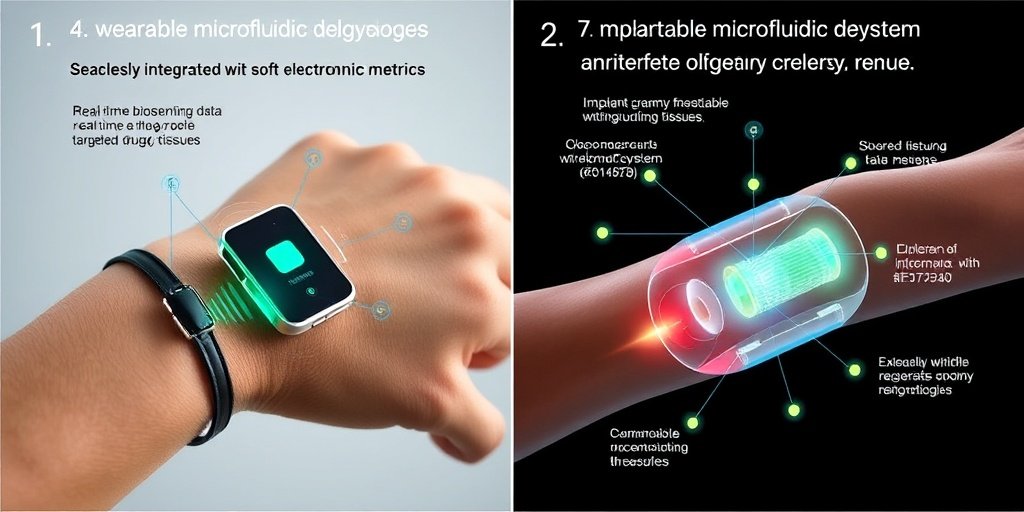⚡ Quick Summary
This review explores the rapid advancements in microfluidic technologies for wearable and implantable biomedical systems, emphasizing their potential in real-time biosensing and targeted drug delivery. The integration of these technologies with artificial intelligence and soft electronics is set to revolutionize digital therapeutics in healthcare.
🔍 Key Details
- 📊 Focus: Wearable and implantable microfluidic systems
- ⚙️ Key Technologies: Soft electronics, wireless communication, multimodal sensing
- 🔍 Critical Directions: System-level stretchability, multimodal module integration, AI-driven data processing
🔑 Key Takeaways
- 💡 Microfluidic technology has evolved from lab-on-a-chip applications to biomedical systems.
- 🌐 Integration with soft electronics enhances adaptability in biological environments.
- 🤖 AI-driven data processing is crucial for developing intelligent therapeutic platforms.
- 🏥 Potential applications include real-time biosensing and closed-loop therapeutics.
- 🔄 Future systems aim to be personalized and seamlessly integrated into daily healthcare.
- 📈 Advancements in microfluidics could lead to significant improvements in patient outcomes.
- 🌍 The review highlights the importance of multidisciplinary approaches in healthcare technology.

📚 Background
Microfluidic technology has traditionally been associated with laboratory applications, enabling precise fluid handling on a miniature scale. However, its recent expansion into wearable and implantable systems marks a significant shift, allowing for real-time monitoring and intervention in patient care. This evolution is particularly relevant in the context of digital therapeutics, where personalized and responsive healthcare solutions are increasingly in demand.
🗒️ Study
The review conducted by Lee et al. provides a comprehensive overview of the latest advancements in microfluidic platforms designed for integration with the human body. It emphasizes the importance of key design strategies, such as the incorporation of soft electronics and wireless communication, which enhance the functionality and adaptability of these systems in dynamic biological environments.
📈 Results
The authors identify three critical technological directions for advancing digital therapeutics: system-level stretchability, multimodal module integration, and AI-driven data processing. These advancements are expected to transform current microfluidic systems into intelligent, autonomous platforms capable of delivering personalized healthcare solutions.
🌍 Impact and Implications
The implications of this research are profound. By harnessing the capabilities of microfluidic technologies, healthcare can become more personalized and responsive. The integration of AI and multimodal sensing will enable healthcare providers to monitor patients in real-time, leading to timely interventions and improved health outcomes. This shift could redefine the landscape of digital therapeutics, making healthcare more accessible and efficient.
🔮 Conclusion
The advancements in wearable and implantable microfluidic technologies represent a significant leap forward in the field of digital therapeutics. As these systems become more intelligent and integrated into everyday healthcare, they hold the promise of delivering personalized and responsive care. Continued research and development in this area are essential to fully realize the potential of these innovative technologies.
💬 Your comments
What are your thoughts on the future of microfluidic technologies in healthcare? We would love to hear your insights! 💬 Leave your comments below or connect with us on social media:
Wearable and implantable microfluidic technologies for future digital therapeutics.
Abstract
Microfluidic technology, originally developed for lab-on-a-chip applications, has rapidly expanded into wearable and implantable biomedical systems, enabling precise fluid handling for real-time biosensing, targeted drug delivery, and closed-loop therapeutics. This review provides a comprehensive overview of recent advancements in microfluidic platforms designed for integration with the human body, focusing on both wearable devices and implantable systems. Key design strategies are highlighted, including the integration of microfluidics with soft electronics, wireless communication, and multimodal sensing to enhance mechanical adaptability and functional versatility in dynamic biological environments. In addition, three critical technological directions for advancing digital therapeutics are discussed, particularly focusing on system-level stretchability, multimodal module integration, and artificial intelligence-driven data processing. These capabilities will serve as the foundation for transforming current microfluidic systems into intelligent, autonomous platforms, which will play a pivotal role in shaping future digital therapeutics that are personalized, responsive, and seamlessly integrated into everyday healthcare.
Author: [‘Lee S’, ‘Chung WG’, ‘Kim E’, ‘Kim E’, ‘Paek J’, ‘Kim D’, ‘An SH’, ‘Lee T’, ‘Lim JA’, ‘Park JU’]
Journal: Lab Chip
Citation: Lee S, et al. Wearable and implantable microfluidic technologies for future digital therapeutics. Wearable and implantable microfluidic technologies for future digital therapeutics. 2025; (unknown volume):(unknown pages). doi: 10.1039/d5lc00525f